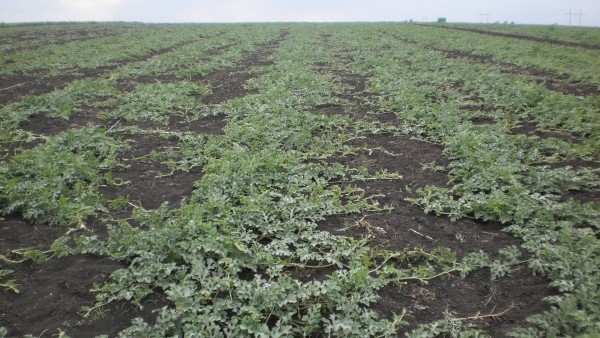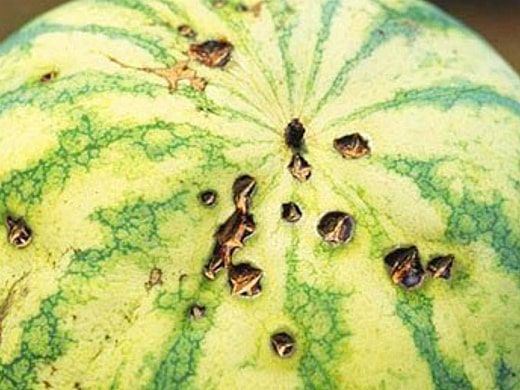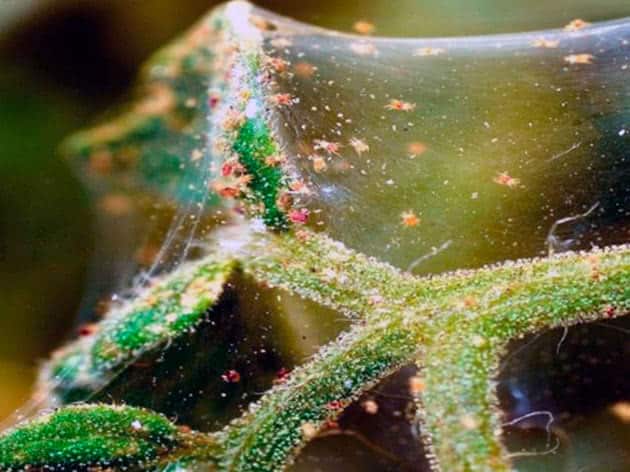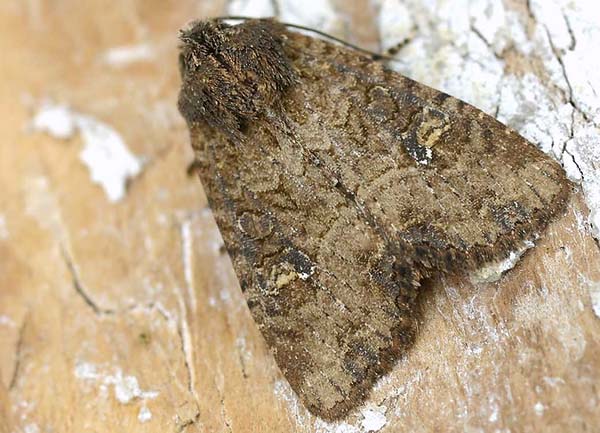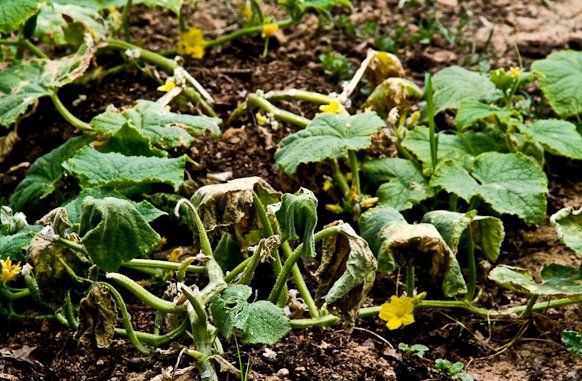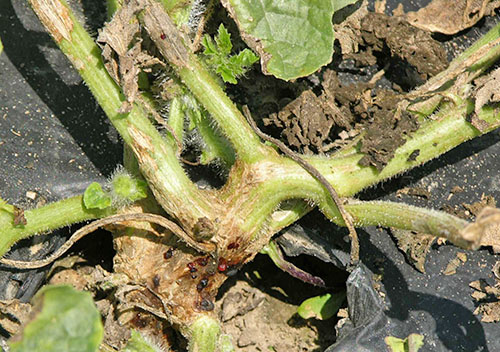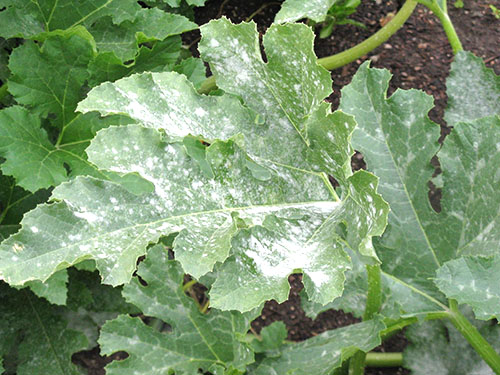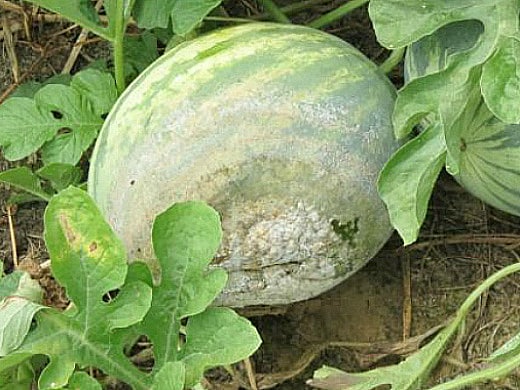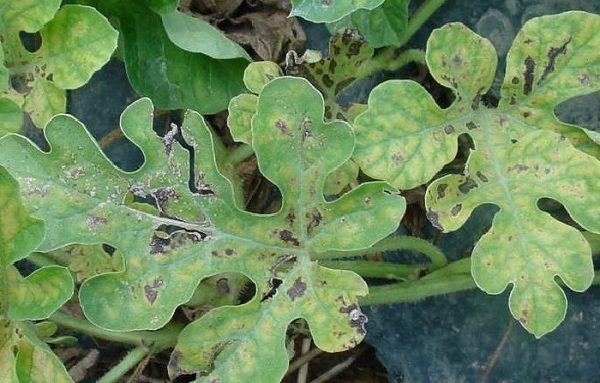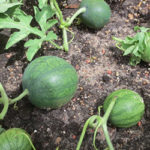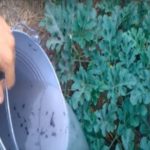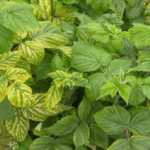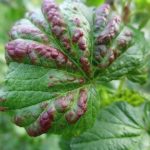Watermelons are considered a common plant that is loved by almost every gardener. When growing pumpkin crops, many people pay attention to proper care of the bushes and pay virtually no attention to watermelon diseases. However, care must be taken to ensure that the seedlings do not become infected with anything, since the development and productivity of sick plants deteriorate.
- What measures must be taken to protect plants and fruits from pests?
- Biological
- Chemical
- Main signs of plant disease
- Types of watermelon pests and ways to combat them
- melon aphid
- Wireworm
- Spider mite
- Thrips
- Sprout fly
- Root nematode
- Owl butterflies
- Locust
- Birds
- Descriptions of symptoms and methods of treating watermelon diseases
- Fusarium
- Anthracnose
- Root rot
- Bacterial spot
- Powdery mildew
- Downy mildew
- White rot
- Gray rot
- Mosaic disease
- Leaf rust
- Olive spot
- Preventive measures
- Conclusion
What measures must be taken to protect plants and fruits from pests?
Often, due to the appearance of dangerous pests, watermelon bushes stop bearing fruit and die. To protect seedlings from insects, it is recommended to take the necessary protective measures in advance. They are performed in three successive stages:
- Spring. The first stage is carried out in mid-spring, after planting the seeds in the garden. It is during this period that all insects wake up after winter and become more active. During the spring stage of protecting seedlings, all bushes are treated with special protective agents.
- Summer. The next stage begins in the summer, when the planted crop began to bloom and gradually grow fruit. Summer treatment of seedlings is mandatory, since insects become more aggressive in summer.
- Summer-autumn. If the two previous treatments were unsuccessful, you will have to treat each ovary a third time. You should spray the bushes no earlier than 20-30 days before harvesting ripe fruits.
Before you start processing watermelon seedlings, you need to familiarize yourself with effective means of protection.
Biological
To protect plants in the garden, biological agents are often used. If the first signs of the presence of insects appear on the bushes, you must immediately get rid of the leaves on which their eggs are laid.Torn leaves should not be left on the site, as eggs will still develop on them. Therefore, experienced gardeners advise burning them.
Also among the biological protective agents are onion and garlic tinctures, which can prevent the death of watermelons from insects.
To prepare the mixture, add 300 grams of chopped garlic to ten liters of water. Then the product is infused for 30-40 minutes, after which it is filtered. The prepared solution is enough to treat five square meters of garden.
Chemical
When biological agents do not help protect watermelon bushes, chemicals are used. Gardeners advise using them if the number of pests on the bushes is constantly growing. For example, you need to use such preparations if there are more than five spider mites, gall midges or aphids on each leaf. To completely clean the seedlings from pests, you need to treat them with a solution prepared from Keltan. You can spray the plants with the chemical before fruit sets.
Main signs of plant disease
Determining that a watermelon is sick with something is quite simple. To do this, it is enough to familiarize yourself with the main features of the manifestation of watermelon diseases.
There are several signs that most often appear in diseased bushes:
- Withering. The most common symptom of most pathologies is that the leaves of seedlings wither. At first, only the leaves suffer from wilting, but then it spreads to the stems. Most often, leaves dry out due to lack of moisture or due to exposure to pathogens. The symptom appears after bacteria or fungi enter the leaves of the plant.
- Rotting.Common signs of powdery mildew and other pathologies developing in watermelons include rotting. In the first days of the onset of symptoms, the leaves of the bushes curl, after which their tissues begin to decompose and soften. Over time, rotting spreads to the root system and watermelon fruits.
- Necrosis. The most dangerous signs of pathologies include the development of necrosis, which leads to the death of plants. First, watermelon leaves turn yellow and become covered with dark spots. Spotting on leaves can differ in color, size, shape, border and speed of development. If you do not treat the disease that caused necrosis, the seedlings wither and the bushes die.
- Deformation. Under the influence of certain diseases, watermelon seedlings begin to deform. First, the shape changes in young leaves. Gradually, fruits, stems and even the root system are subject to deformation. Due to damage to the roots, the bushes slow down their growth and begin to dry out.
- Neoplasms. There are cases when tumors appear on the bushes due to bacterial or fungal pathogens. Such new growths can appear on any part of the bushes.
Types of watermelon pests and ways to combat them
At growing watermelons in open ground, and even in greenhouse conditions, gardeners often encounter dangerous pests that slow down the development of seedlings and worsen yields.
It is recommended to familiarize yourself in advance with the most dangerous insects and methods of combating them in order to quickly get rid of pests.
melon aphid
When growing watermelons in the garden, gardeners often have to deal with such dangerous insects as aphids. Such pests can be seen on fruits, leaves, flowers and stems.It is very difficult not to notice aphids, since they densely cover the surface of plants. Areas where insects have been present for a long time become covered with a thick transparent liquid.
If you do not treat the bush with aphids in a timely manner, it will begin to dry out and gradually die. To get rid of insects, they use effective folk remedies that can be prepared at home. Aphids do not like the aroma of plants such as garlic and onions. Therefore, it is better to deal with the pest with solutions prepared from these ingredients.
Wireworm
Inexperienced gardeners are sure that this pest appears only on young potato bushes. However, pumpkin plants are also susceptible to attacks by wireworms, which can completely destroy the crop. This beetle is dangerous because it eats holes in watermelon fruits, which begins the process of rotting.
Wireworms often appear in acidic soils, and therefore, before planting watermelons, the area is thoroughly treated with ash and flour. This will reduce the acidity of the area several times and reduce the likelihood of beetles appearing.
Spider mite
It is very difficult to notice mites, since they are small and at first settle only on the inside of the leaf. After the pest appears, brown spots form on the surface of the leaves, the diameter of which gradually increases. Then barely noticeable threads appear in them, which look like a cobweb. It is recommended to immediately clear the bushes of ticks, as the affected plants will die. Folk methods and remedies made from garlic heads will help fight mites. Infected seedlings must be treated at least twice every 10-15 days.
Thrips
Thrips look like thin lines of dark color that are difficult to notice.Insects appear on the surface of the leaves and feed on their juice. A week after thrips appear, all damaged leaves wither and fall off. Gradually, the pests move onto the stems of watermelon bushes, causing them to become discolored. To get rid of thrips, you need to use decoctions of chamomile or tomato tops.
Biological preparations, including Karate, Spintor and Vermitec, will also help cope with the insect. Bushes are treated with such means at least three times a week.
Sprout fly
The sprout fly is considered the most dangerous pest for young watermelon bushes. It is capable of completely chewing out the inside of the stems, which leads to drying out of the bushes. The fly first feeds on newly planted seedlings. After a few months, the insect begins to destroy the grown bushes.
To protect plants from flies, you need to dig up the area in advance and clear it of weeds. Also, for prevention, special disinfectants are used in which the seed material is treated.
Root nematode
Among the dangerous parasites that lead to the death of watermelon fruits is the root-knot nematode. Outwardly, it resembles a small worm measuring 2-3 centimeters. The nematode develops at high temperatures of about 35 degrees and high humidity. First, the parasite damages the root system, which makes the bush absorb nutrients and moisture worse. This leads to curling of the leaves and drying out of the seedlings. It is impossible to get rid of nematodes using folk remedies, and therefore gardeners have to use chemicals. The bushes are treated with chemicals 2-3 times a week.
Owl butterflies
Squash plants are often attacked by cutworms that feed on the leaves.During the day, their caterpillars are in the soil, and at night they climb to the surface to eat leaves with shoots. Yellowish, oval-shaped spots appear in areas damaged by caterpillars.
To get rid of cutworms, you will have to regularly spray the bushes with a solution made from young wormwood. When preparing such a tincture, 400 grams of herb are mixed with 80 grams of soap and 60 grams of ash. Then all the ingredients are poured into 8-10 liters of water and placed on the stove to boil. The solution is infused for 3-4 hours, after which the infected seedlings are sprayed with it.
Locust
Plants grown in the garden are often attacked by locusts, which are considered a dangerous pest.
For melon crops, not only locusts are dangerous, but also their larvae, which penetrate the root system and gradually destroy it.
Locust larvae can be stored in the soil, so in order to get rid of them in advance, you need to dig up the area and disinfect it with hot water. Chemicals such as Zeon and Taran will also help protect seedlings from locusts.
Birds
Watermelon attracts not only insects, but also birds. Pigeons, crows and starlings love to eat them. Birds often peck at the fruits, which causes dangerous bacteria to get into them, and the watermelon rots. To protect seedlings, textile nets are used to cover watermelon bushes. Also, each seedling can be covered with a box, which will prevent birds from reaching the fruits.
Descriptions of symptoms and methods of treating watermelon diseases
Fungi and bacteria often cause the appearance and development of diseases, leading to the death of planted watermelons. In order to identify them in a timely manner and get rid of them, you need to familiarize yourself with the list of common diseases in advance.
Fusarium
Fusarium wilt occurs due to the effects of a fungus that has entered the pumpkin plant through the roots. Infected bushes become covered with oval spots with a light coating on the surface. The infection then spreads to the rhizomes, causing them to rot and stop functioning.
To eliminate the disease, seedlings are treated with Krezacin or any other drug with the same effect is used.
Anthracnose
Anthracnose is an infection that causes all the leaves to become covered with yellowish spots. Gradually, the spots increase in size, and a bulge appears on their surface. If anthracnose is not treated, the spotting will darken and the bushes will begin to deform and rot. To get rid of signs of anthracnose, melons are treated with a weakly concentrated Bordeaux mixture. In this case, spraying should be carried out very carefully so that the liquid covers the surface of each bush.
Root rot
Increased soil moisture promotes the development of a fungal disease such as root rot. It is difficult not to notice the signs of pathology, since infected seedlings become covered with dark spots. When root rot becomes active, the roots in the soil enlarge and become covered with cracks, which leads to the death of watermelons.
You can get rid of root rot only at the initial stage of its development. To do this, reduce watering of the area and treat the ground with ash and vitriol.
Bacterial spot
The disease is transmitted to healthy bushes by insects. The causative agents of spotting become active in the first half of summer, when the air warms up to thirty degrees Celsius. Infected bushes will turn yellow, become covered with small oblong spots and dry out. When signs of spotting appear, all infected leaves are torn off and burned.This will prevent further development of the bacterial disease.
Powdery mildew
It is difficult to confuse powdery mildew with another disease, since infected watermelons are covered with a white coating that looks like flour. When the disease moves to the next stage of development, the plaque darkens and turns brown. Bushes with powdery mildew wither and their fruits darken.
After detecting signs of pathology, the plants should be immediately sprayed with Karatan or Topaz. Gardeners advise picking and burning infected fruits and leaves before spraying.
Downy mildew
To make sure that a watermelon is infected with downy mildew, you need to carefully examine the leaves. Their inside is covered with a purple coating, and round, light spots form on top. Gradually the leaves dry out and become wrinkled. The disease also spreads to fruits, which become discolored and tasteless.
A sulfur solution, which is sprayed on the soil and leaves of watermelons, will help eliminate downy mildew.
White rot
Signs of white rot appear on plants at high air humidity and low temperatures. First, the stems and leaves are covered with a thin white coating. Then it darkens and leads to rotting of the shoots. It is impossible to cure infected areas, so you will have to cut them off. Afterwards, the sections are treated with a solution of activated carbon or sulfur.
Gray rot
The causative agents of this disease are found in the remains of weeds and other plants. Therefore, watermelons most often suffer from gray rot if they were planted in uncleaned areas. Infected leaves become covered with gray spots and a dark coating. You can get rid of gray rot only at the initial stage of its development. To do this, all plants are treated with Topaz or Teldor.
Mosaic disease
The development of a mosaic disease is indicated by the appearance of light spots on the leaf blade. When the mosaic begins to develop, the sheets change shape, they dry out and fall off. Also, signs of the disease appear on fruits that become covered with bumps. To prevent mosaic, it is recommended to treat seedlings twice a month with Karbofos.
Leaf rust
Leaf rust affects plants due to the influence of rust plants on bushes. The disease is accompanied by the formation of tubercles on leaves and stems. After 2-3 days, they crack and spores spill out, which can infect neighboring plants. Only fungicidal preparations will help get rid of rust.
Olive spot
Signs of pathology appear on young fruits, the surface of which is covered with sunken olive-colored spots. Then the spotting spreads to the stems and leaves, which begin to dry. To eliminate manifestations of olive spotting, watermelons are treated with Bordeaux solution.
Preventive measures
Melons and melons are more likely than other plants to be attacked by pests and become infected with diseases. It is recommended to take preventive measures in advance to protect the seedlings. To do this, every vegetable grower must carefully inspect the bushes every day, this will allow any changes to be detected in time. Pre-sowing disinfection of soil and planting material will also help prevent many diseases. To do this, all the seeds are soaked in a manganese solution, and the soil is spilled with boiled hot water.
Conclusion
Most gardeners grow watermelons and other melons. When cultivating such plants, you often have to deal with dangerous insects and diseases. To get rid of them, you need to familiarize yourself with the description of pests and ailments, and also study ways to combat them.

